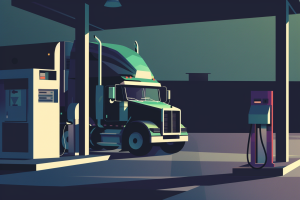- 2024 Trucking Costs: Rising or Stabilizing? Discover how shifts in driver wages, insurance premiums, and fuel costs are shaping the financial landscape of the trucking industry this year.
- Safety Over Starting Bonuses: For the first time, safety bonuses surpass starting bonuses in trucking—what does this mean for driver retention and operational strategy?
- Navigating New Norms: With trucking operational costs subtly increasing, find out how industry leaders are adapting to keep their fleets economically viable in a changing market.
Overview of Trucking Costs in 2024

In 2023, trucking costs soared to a record high of $2.27 per mile, a nuanced increase that highlights the ongoing economic pressures.
As the backbone of the American economy, the trucking industry’s cost dynamics are critical for both economic analysts and industry participants. In 2023, trucking costs reached a new all-time high at $2.27 per mile, reflecting a nuanced increase of less than 1% from the previous year. For more insights into the American Transportation Research Institute’s (ATRI) ongoing research and its impact on the trucking industry, explore this page.
Analyzing the Subdued Cost Increase
Despite global challenges and economic shifts, the overall increase in trucking costs has been moderated by several factors, including a notable decrease in fuel expenses and various efficiency measures adopted by fleets. Stay informed on the latest developments and trends shaping the trucking industry, visit this link.
The Role of Fuel Costs
Decreasing Fuel Prices Offer Relief

Fuel expenses continued to decline in 2024, offering much-needed relief against other rising operational costs in the trucking sector.
Early indications from 2024 suggest a continuation of the declining trend in fuel costs, which decreased significantly from 64 cents per mile in 2023 to 55 cents. This drop has provided a buffer against other rising expenses in the trucking sector, particularly noted in the overall 2024 trucking costs. Stay updated on the latest trends in fuel costs and their implications for the trucking sector, check out this link.
Impact of Macro-Economic Factors
“The overall macroeconomic conditions, including a cooled inflation rate at 3.4% and an improvement in GDP growth in the second half of the year, have also played a role in stabilizing some of the costs associated with trucking operations.” Understand how macroeconomic factors like GDP growth and inflation rates are impacting trucking operations, explore this page.
Enjoying our insights?
Subscribe to our newsletter to keep up with the latest industry trends and developments.
Stay Informed
Driver Wages and Compensation Trends
Stabilizing Driver Wages

Driver wages in 2023 increased by 7.6%, reflecting a significant moderation compared to the steep hikes of previous years.
Driver wages, typically the largest component of trucking costs, rose by 7.6% in 2023, markedly lower than the previous year’s 15.5% increase. This moderation reflects broader industry trends of stabilizing pay scales after years of sharp hikes. Explore the latest strategies and trends surrounding driver wages and retention within the trucking industry, check out this page on wages and this page on retention.
Safety Bonuses versus Starting Bonuses
In a notable shift within compensation structures, safety bonuses have for the first time surpassed starting bonuses, averaging $1,831, reflecting the industry’s increased focus on safety and driver retention.
Rising Insurance Premiums Challenge Fleets

Insurance premiums rose by 12.5% in 2023, driven by escalating vehicle costs and heightened litigation risks.
Insurance premiums, a critical component of 2024 trucking costs, saw a significant rise of 12.5% in 2023. This increase is largely due to the higher costs of trucks and ongoing litigation risks, which have become more pronounced in an environment of heightened regulatory scrutiny. To dive deeper into the rising insurance premiums and their economic effects on fleet management, visit this link.
Equipment and Operational Expenditures
Surging Equipment Costs
Investments in new trucks and trailers escalated significantly, with an 8.8% increase in equipment expenses in 2023, further influencing the financial dynamics of the trucking industry.
Repair and Maintenance Costs

In 2023, maintenance costs rose by 3.1%, highlighting the ongoing struggle to maintain an aging fleet amidst tightening economic conditions.
Repair and maintenance costs also saw an increase, rising by 3.1% to $0.202 per mile in 2023. These costs reflect the ongoing need for upkeep and the impact of an aging fleet on operational budgets. For additional insights into the operational costs and challenges faced by the trucking industry, follow this link.
Sector-Specific Financial Dynamics
Truckload and Specialized Sectors
Excluding fuel, the truckload sector saw a cost increase of 3.9%, while the specialized sector remained stable. However, the less-than-truckload (LTL) sector witnessed a significant 15.6% jump in 2023, primarily driven by heightened competition for drivers and market disruptions following the closure of Yellow Corp.
Increased Deadhead Mileage and Driver Turnover

The LTL sector experienced a dramatic 15.6% cost increase in 2023, spurred by intense competition for drivers and market disruptions.
Operational inefficiencies such as increased deadhead mileage, which rose to an average of 16.3% for all non-tank operations in 2023, and a rise in driver turnover by five percentage points in the truckload sector, have also added to the cost pressures.
Looking Ahead: Future Cost Projections
While early trends in 2024 suggest potential reductions in fuel costs, the overall financial health of the trucking industry remains complex, with varying impacts across different segments. These nuances underline the importance of strategic planning and operational adjustments in response to evolving economic conditions. For more news and updates on financial challenges facing the trucking industry, click here.
For more detailed insights, you can access the full report directly from the ATRI site here.
Strategic Insights: Key Developments in Trucking Costs for 2023-2024
- Insurance Premiums on the Rise: In 2023, truck insurance premiums experienced a 12.5% hike, a reflection of increased vehicle costs and heightened litigation risks—a pivotal trend affecting fleet management strategies.
Early trends in 2024 indicate potential reductions in fuel costs, hinting at possible economic stabilization for the trucking industry.
- Moderation in Driver Wages: Despite previous volatility, driver wages saw a more subdued increase of 7.6% in 2023, signaling a trend towards stabilization that may influence future labor negotiations and cost management.
- Fuel Costs Trend Downward: Building on the trend from the previous years, fuel costs continued to decrease in 2023, providing some relief against other rising operational expenses and influencing strategic decisions around fleet operations and budgeting.
- Technological Adaptations: An enhanced focus on safety and efficiency technologies, such as on-site fueling services, proved crucial in 2023 for managing rising operational costs, pointing to a broader shift towards more sustainable and cost-effective practices in the trucking sector.
To explore in-depth reports and analysis on the trucking industry’s financial landscape, check out this page, and for the latest trends impacting the trucking industry in 2024, follow this link.





















